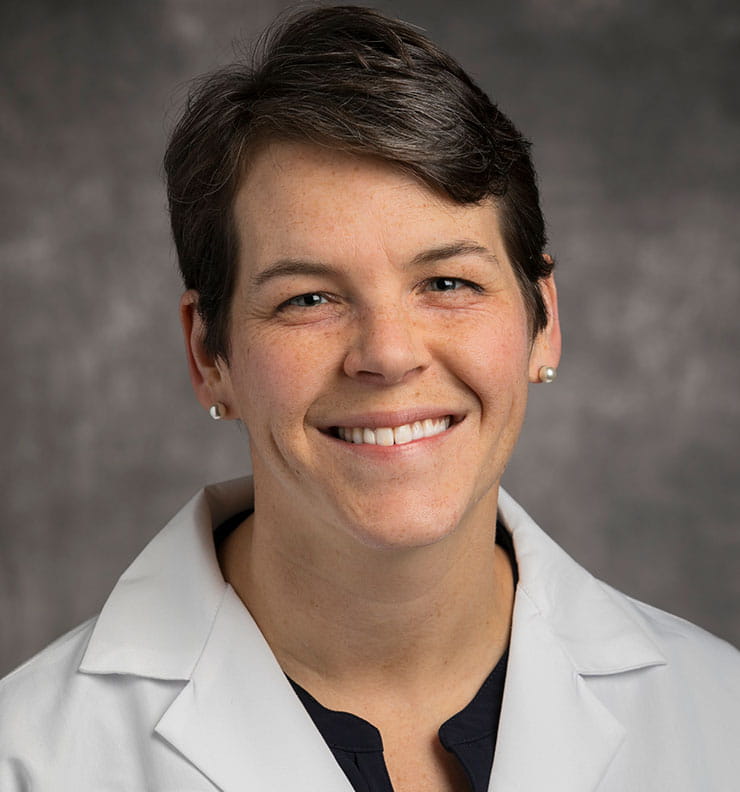Children with Scoliosis Benefit from Night Time Bracing Offered at UH Rainbow Babies & Children’s Hospital
February 20, 2024

Study provides precise counseling for patients and their families
Innovations in Pediatrics | Winter 2024
Idiopathic scoliosis is the most common spinal deformity in children, and a nocturnal or night brace, such as the Providence® or Boston Night Shift brace, is an important therapeutic option for these young patients. Yet no large studies have explored the success of night bracing to prevent scoliosis surgery.
 Christina Hardesty, MD
Christina Hardesty, MDA team of pediatric orthopaedic surgery specialists from UH Rainbow Babies & Children’s has created a predictive model identifying the factors that lead to success for young patients with idiopathic scoliosis during treatment with a night brace. This new information provides important guidance for both clinicians and parents. The model relies on 26 years of data on idiopathic scoliosis patients treated at UH Rainbow, spanning from 1994 to 2020. The team published its model recently in the Journal of Pediatric Orthopaedics.
Nocturnal braces, unlike the standard day time brace, are worn only at night. While the patient is lying down, gravity has less effect on the spine and the brace can do a better job of correcting the curve. There’s also less pressure and better compliance when the social aspects of daytime brace wear are eliminated. This means compliance rates can be higher.
Why Predicting Matters
“Being able to predict the likelihood of scoliosis surgery during bracing is important for several reasons,” says study co-author Christina Hardesty, MD, pediatric orthopaedic surgeon at UH Rainbow. ”It can identify high-risk candidates and lead to earlier implementation of bracing in some cases. It can be used as a factor in counseling patients about complying with their bracing intervention. At the same time,” she says, “it can identify patients who require closer follow-up and help doctors choose the best type of brace.”
Making the Model
In developing the model, the research team included retrospective data from 329 UH Rainbow pediatric patients with idiopathic scoliosis. Factors included age, sex, body mass index, Risser classification, Lenke classification, curve magnitude at brace initiation, percentage correction in a brace and total months of brace use.
“The Risser classification system is designed to identify the amount of growth remaining at the iliac growth plate,” Dr. Hardesty says. “The Lenke classification looks at curves and identifies how the curve is shaped as well as its location in the spine. This matters because some curves respond better to bracing than others.”
Study Results
Dr. Hardesty says that one key take-home message from this large study is that Providence bracing works as a treatment for idiopathic scoliosis.
“We're able to say that Providence braces have a pretty equivalent outcome compared to other types of braces because the success rate was similar,” she says. “We were able to prevent curve progression in the majority of patients, around 66%.”
Of those 34% of patients who did ultimately require surgery, the initial curve magnitude and duration of bracing were the two most predictive features for curve progression leading to surgery, she says.
Herculean Effort
Dr. Hardesty says this project would not have been possible without the exemplary and thorough work of George Thompson, MD, former Chair of Pediatric Orthopaedics at UH Rainbow, and Connie Poe-Kochert, CNP, who have followed virtually all the patients in this study for many years. She says she and her colleagues are pleased to contribute to this study, which could make a difference for so many families dealing with the difficult diagnosis of a child with idiopathic scoliosis.
“The model provided in this study should help guide orthopaedic surgeons regarding the decision to treat pediatric patients with idiopathic scoliosis non-operatively or with surgery, after external validation,” the team writes. “Another benefit of a highly predictive model includes more precise counseling for patients and their families.”
“Finally, teams treating patients with idiopathic scoliosis can feel more confident about choosing a night-time brace for patients who might have trouble using a daytime brace,” Dr. Hardesty says.
For more information about this study, please email Peds.Innovations@UHhhospitals.org.
Contributing Expert:
Christina Hardesty, MD
Pediatric Orthopaedic Surgery
UH Rainbow Babies & Children's Hospital
Associate Professor of Orthopaedics
Adjunct Professor of Pediatrics
Case Western Reserve University School of Medicine


